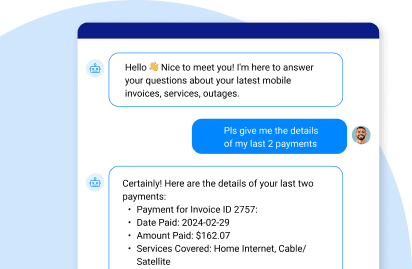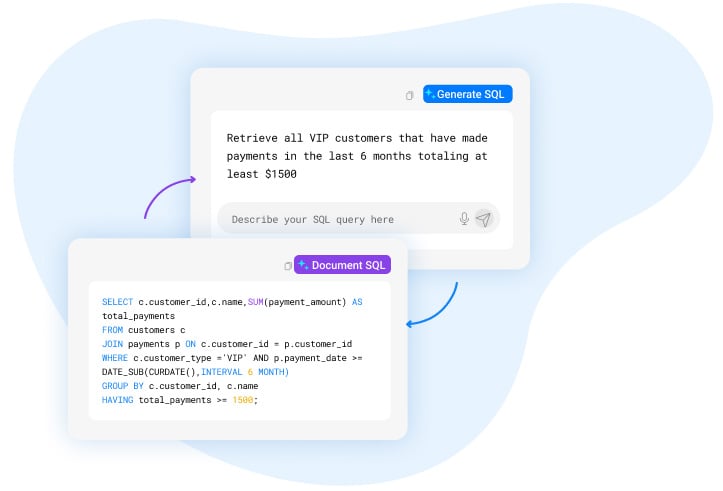LLM-based text-to-SQL is the process of using Large Language Models (LLMs) to automatically convert natural language questions into SQL database queries.
The rise of AI-generated SQL
Generative AI has unlocked many valuable use cases, including reading, writing, and debugging complex SQL (Structured Query Language), the lingua franca of databases.
The ability to easily and quickly generate SQL from a natural language interface is both novel and promising. It opens the door to a new set of use cases, where LLM-based chatbots can translate a user question into a series of SQL statements – to retrieve the relevant data and answer the question accurately and greatly enhance the customer experience.
LLM-based text-to-SQL is a game-changer for organizations seeking to maximize the value of their LLMs by augmenting them with AI-ready data straight from their enterprise systems – through frameworks like Table-Augmented Generation (TAG) and Retrieval-Augmented Generation (RAG).
However, while promising to boost customer experience and productivity, the LLM text-to-SQL model also has its pitfalls, including:
-
Lack of schema awareness
-
Inaccurate results
-
Data security risks
In this article, we’ll review these limitations and offer some helpful tips for overcoming them.
Understanding LLM-based text-to-SQL
LLMs demonstrate a remarkable ability to understand and generate programming code, like SQL, based on natural language prompts – from simple queries, to complex database operations involving multiple tables, filters, and sophisticated SQL features. By translating plain text requests into appropriate SQL statements, LLMs empower non-technical users to access vast corporate data resources.
With LLM text-to-SQL processes in place, you can use enterprise structured data to deliver personalized, context-sensitive, and accurate LLM responses, such as those required for a customer service RAG chatbot. LLM grounding can also improve your organizational processes, such as back-office processing, employee onboarding and knowledge transfer
While the ability to generate SQL with AI can democratize access to AI-ready data and increase productivity, it can also expose data to significant performance and security issues. It’s important to acknowledge these limitations and use preemptive best practices to avoid them.
Limitations of LLM text-to-SQL
There are 4 fundamental major challenges associated with the LLM text-to-SQL approach:
1. Schema awareness
LLMs need to be aware of relevant database schema to generate accurate SQL queries, and the schema must be contextual with rich metadata. While this is simple for smaller databases, it's challenging for databases with hundreds or thousands of tables and columns, spanning multiple systems and technologies.
To be effective, LLMs must be aware of and use trusted data sources like master data management and data catalog systems in conjunction with active retrieval-augmented generation to ensure they generate SQL queries that provide accurate and consistent results.
2. Accuracy of results
AI-generated SQL queries face several challenges in producing accurate results, including AI hallucinations, erroneous column names, misunderstood schemas, and poorly executed AI prompt engineering.
Real-world enterprise systems and databases present additional complexities due to highly-complex schemas, which may exceed your LLM’s prompt limits. AI systems also struggle with nuanced contexts, such as understanding the specific meaning of generic column names (e.g., "date" in different contexts).
Without rich metadata, LLMs risk misinterpreting data structures, potentially leading to misleading or inaccurate query results in complex enterprise environments.
3. Performance
It’s not easy to calculate the efficiency of AI-generated SQL, since very different SQL statements can arrive at the same result.
Extensive schemas, ambiguous column names, and lack of appropriate database indexes pose additional difficulties. Non-optimized queries can result high-latency and high-resource usage, which could lead to unexpected costs.
The disconnect between applying the latest prompt engineering techniques and SQL expertise can complicate efforts to generate queries and may necessitate multi-disciplinary teams for effective implementation.
4. Security
An enterprise LLM can pose significant security risks. While the ability to generate SQL from natural language interfaces can democratize data access, it's important to note that it can expose data to significant security risks.
Concern over public LLMs exposing confidential data has already led many companies to ban their use. However, even self-hosted LLMs can compromise security if given unrestricted access to enterprise systems. In customer service applications for example, LLMs could be manipulated to reveal PII and sensitive customer data.
While protective measures such as dynamic data masking and multi-factor authentication do exist, LLM security doesn’t happen automatically. Implementing these guardrails requires careful planning and execution.
Webinar: "The Realities of RAG and Text-to-SQL"
What’s hype, what’s real, and how enterprises are making it work in production.
Watch now →
Reducing the risks of LLM text-to-SQL models
Here are 3 ways to reduce the risks of LLM-based text-to-SQL procedures:
1. Make sure your LLM is schema-aware
Companies invest heavily in master data management systems that employ complex survivorship rules to determine the most trustworthy data sources and create consistent golden records.
For LLMs to generate accurate SQL queries, they must be made aware of, and be able to utilize, these curated AI data sources – because relying on raw operational data would likely result in unresolved inconsistencies.
2. Use chain-of-thought prompting
Researchers have found that chain-of-thought prompting, which breaks queries into simpler steps with intermediate reasoning, significantly improves LLM-generated SQL quality.
This approach, while potentially requiring multiple LLM functions for each sub-query, often produces better results. And an iterative process involving a human in the loop and more refined RAG prompt engineering can further enhance the accuracy and efficiency of the generated SQL statements, while reducing their complexity.
3. Implement LLM security guardrails
Securing LLMs for SQL generation and usage requires a comprehensive set of guardrails, including data encryption, PII masking, multi-factor authentication, and regular security audits.
In the context of a RAG chatbot, your LLM can be trained to detect unusual conversation patterns or sensitive inquiries. Plus, regular monitoring and security reviews of your LLM are essential to minimizing risks and maintaining data integrity.
Realizing the potential of LLM text-to-SQL
Using LLMs to generate SQL creates the potential for democratizing data access, enhancing the customer experience, and boosting productivity. However, it also introduces critical challenges in accuracy, performance, and security.
To harness the benefits of LLM-based text-to-SQL, focus on improving schema awareness, using chain-of-thought prompting, establishing robust security measures, and using LLM agents and functions to make it all happen. By addressing these key areas, you can leverage AI-generated SQL to use your data more efficiently, improve your decision-making processes, and safeguard your customers’ PII and other sensitive data.
See how grounding LLMs in enterprise data boosts precision. Discover GenAI Data Fusion →
Final Thoughts
The integration of Large Language Models into SQL querying presents both opportunities and challenges. While the automation of query generation can enhance efficiency, it's imperative to address potential risks such as data security and query accuracy. By understanding these challenges and implementing robust solutions, organizations can harness the full potential of LLMs in data management.

Want to see it in action?
Discover how your enterprise can use GenAI and LLMs to securely generate SQL at scale.
Book a demo →



















